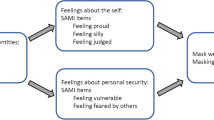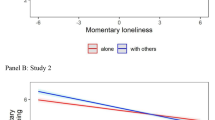Abstract
The behavioral consequences of crowding are analyzed in terms of mediation by the amount of interference experienced in a setting. It is argued that the amount of interference is the major determinant of crowding stress and one of several determinants of the subjective feeling of being crowded. Research implications of this analysis are discussed.
Similar content being viewed by others
References
Altman, I.The environment and social behavior. Monterey, Calif: Brooks/Cole, 1975.
Baum, A., & Greenberg, M. Waiting for a crowd.Journal of Personality and Social Psychology 1975,32 671–679.
Baum, A., & Koman, S. Differential response to anticipated crowding: Psychological effects of social and spatial density.Journal of Personality and Social Psychology 1976,34 526–536.
Calhoun, J. B. Population density and social pathology.Scientific American 1962,206 139–148.
Desor, J. A. Toward a psychological theory of crowding.Journal of Personality and Social Psychology 1972,21 79–95.
Draper, P. Crowding among hunter-gatherers: The !Kung Bushmen.Science 1973,182 302–303.
Esser, A. E. A biosocial perspective on crowding. In J. F. Wohlwill & D. H. Carson (Eds.),Environment and the social sciences: Perspectives and applications. Washington, D.C.: American Psychological Association, 1972.
Freedman, J. L., Heshka, S., & Levy, A. Population density and pathology: Is there a relationship?Journal of Experimental Social Psychology 1975,11 539–552.
Freedman, J. L., Klevansky, S., & Erlich, P. The effect of crowding on human task performance.Journal of Applied Social Psychology 1972,8 528–548.
Freedman, J. L., Levy, A., Buchanan, R. W., & Price, J. Crowding and human aggressiveness.Journal of Experimental Social Psychology 1972,5 528–548.
Loo, C. Important issues in researching the effects of crowding on humans.Representative Research in Social Psychology 1973,4 219–226.
Milgram, S. The experience of living in cities.Science 1970, 167, 1461–1468.
Murray, R. Overcrowding and aggression in primary school children. In C. M. Morrison (Ed.),Educational priority, EPA, a Scottish study. Edinburgh: Her Majesty's Stationery Office, 1974.
Proshansky, H. M., Ittelson, W. H., & Rivlin, L. G. Freedom of choice and behavior in a physical setting. In J. F. Wohlwill & D. H. Carson (Eds.),Environment and the social sciences: Perspectives and applications. Washington, D.C.: American Psychological Association, 1972.
Rapoport, A. Toward a redefinition of density.Environment and Behavior 1975,7 133–158.
Ross, M., Layton, B., Erickson, B., & Schopler, J. Affect, facial regard, and reactions to crowding.Journal of Personality and Social Psychology 1973,28 69–76.
Stokols, D. On the distinction between density and crowding: Some implications for future research.Psychological Review 1972,79 275–277.
Stokols, D., Smith, T. E., & Prostor, J. J. Partitioning and perceived crowding in a public space.American Behavioral Scientist 1975,18 792–814.
Sundstrom, E. Toward an interpersonal model of crowding.Sociological Symposium 1975,14 129–144.
Thomas, E. J., & Fink, C. F. Effects of group size.Psychological Bulletin 1963,60 371–384.
Valins, S., & Baum, A. Residential group size, social interaction and crowding.Environment and Behavior 1973,5 421–439.
Reference notes
Worchel, S., & Teddlie, C. Factors affecting the experience of crowding. Paper presented at the meeting of the Eastern Psychological Association, New York City, 1975.
Schopler, J., & Walton, M. The effects of expected structure, expected enjoyment, and participants' internality-externality upon feelings of being crowded. Unpublished manuscript, University of North Carolina, 1974.
MacDonald, W. S., & Oden, C. W. Effects of extreme crowding on the performance of five married couples during twelve weeks of intensive training. Paper presented at the meeting of the American Psychological Association, Montreal, 1973.
Author information
Authors and Affiliations
Rights and permissions
About this article
Cite this article
Schopler, J., Stockdale, J.E. An interference analysis of crowding. J Nonverbal Behav 1, 81–88 (1977). https://doi.org/10.1007/BF01145457
Issue Date:
DOI: https://doi.org/10.1007/BF01145457




